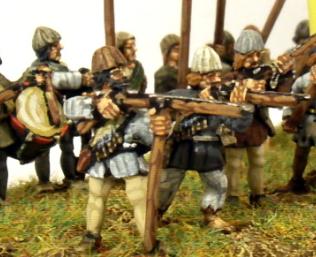Menu
| |
Confederate Irish and Scots, Wars of the Three Kingdoms (ECW/Mid-17th Century Period)

Irish pike and shot infantry painted by "clibinarium."
This line represents the Celtic forces of the Wars of the Three Kingdoms era (English Civil War) -- the Scots and Irish. Much has been written about the Scottish Covenanters as well as Montrose's Scots Royalists so they will not be discussed here. Note that the regular cavalry and infantry of the Scots Royalists (Strathbogie, the Gordon foot and horse) would not be different from the Covenanter range so they are not distinguished here. Many Scottish highlanders were "humblies" who were often just equipped with a polearm and stuck in the back on the force -- even if your army list does not depict these as a separate type it makes good sense to mix some in the rear ranks, and is quite colourful as well.
Perhaps somewhat less well-known (other than for the seconding of some of their troops to Scotland), the Confederate Irish, sometimes with "Redshanks" mercenaries, fought to establish independence in Ireland during the period of the English Civil War, which eventually placed them in the odd position of being Royalists. The Irish Catholic Confederacy begins with the Rebellion of 1641 and ends ten years later with the final defeat of an Irish field army, at the Battle of Knocknaclashy.
Many Irishmen had fought in the Spanish tercios in the interminable wars in the Netherlands and had some military experience, but modern weapons were sometimes in short supply, and as such some Irish armies contained many troops fighting in traditional fashion, with the javelin.
The Confederate Irish were always weak in cavalry compared to their foes, and this, along with often very poor high level leadership, was the cause of their general lack of success on the battlefield. However, when competently led, and when the enemy superiority in horse could be neutralized, the Irish, good solid infantry, were much more successful, as demonstrated by their great victory at Benburb under the command of Eoghan Ruadh O Neill (Owen Roe O'Neill).
Again, the armies of the Covenant and Montrose need no recommendation! The Confederate Irish army is particularly interesting because, whilst still containing a hard core of relatively modern infantry, it can also field large numbers of fierce Redshanks (Highlander equivalents) and native Irish fighting in traditional Irish fashion, a very interesting twist on the typical musket and pike arrays of the period.
Sculpted by "clibinarium."
|
SCOTTISH ARMIES
MONTROSE'S FORCES
CONFEDERATE IRISH
COMMON SETS FOR ALL FORCES
|

